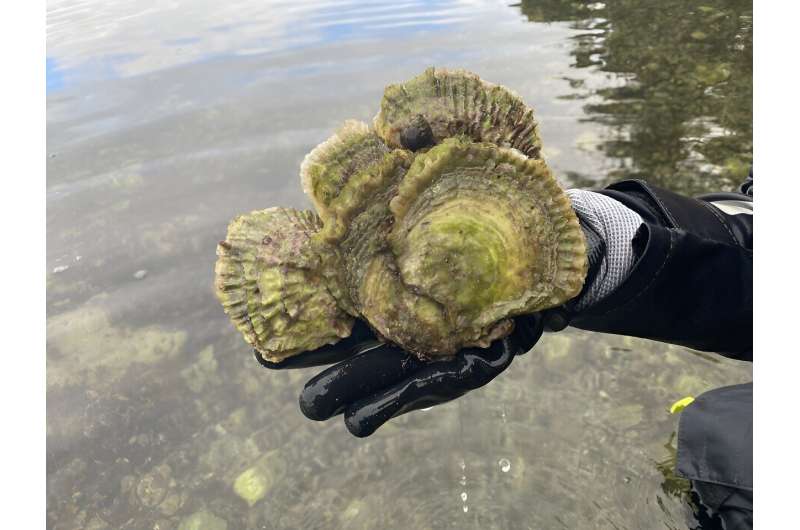This article has been reviewed according to Science X's editorial process and policies. Editors have highlighted the following attributes while ensuring the content's credibility:
fact-checked
proofread
Oysters in Norway can help sick shellfish in Europe

Flat oysters, commonly known as oysters, are considered a delicacy. As a species, they prefer warmer waters and are typically found just below the tidal zone at depths of a few meters.
Oysters are currently confronted with numerous challenges. Their populations have greatly declined throughout Europe, and the species is classified as critically endangered. The main causes include overfishing employing destructive fishing methods, increased pollution, and mass mortalities due to disease outbreaks.
"We have visited around 400 locations from Karmøy in the west to Risør in the east and observed flat oysters in many places. Only in a few places do we find oysters in quantities that can be defined as an oyster bank—an area with more than five oysters per square meter," says Molly Reamon, a Ph.D. research fellow at UiA, who has conducted field surveys together with researchers at UiA and the Institute of Marine Research.
The parasite Bonamia alone has reduced flat oyster cultivation by around 90%.
"Shellfish cannot be vaccinated. It is not possible to get rid of diseases once they have been introduced," says Ane Timenes Laugen, a professor of marine biology at UiA.
"In Norway and Sweden, there are still healthy and viable populations of flat oysters, and therefore we have a special responsibility to ensure that they continue to thrive," says Reamon.
Therefore, the Norwegian flat oysters are of great international interest. Healthy shells can be used to save populations elsewhere in Europe.
"There is an increased demand for healthy oysters including for the restoration of oyster banks," says Laugen.
Flat oysters, like other oyster species, can form large oyster banks which serve as important nursery areas for various species. Dead shells and hollow spaces within the oyster banks provide habitat for worms, crustaceans, and numerous species of small fish.
Nevertheless, unregulated harvesting for the purpose of restoration and consumption can be very harmful to individual populations.
"Except for a small conservation area in Agder, no measures have been implemented to protect Norwegian flat oyster populations from potential threats," says Ph.D. Research Fellow Johanna Bjånes Marcussen, who has also been involved in the research.
The only area in Norway where fishing is completely prohibited covers 0.5 square kilometers and is situated in Tvedestrand fjord in Agder. This area contains some flat oyster habitats. The preservation status of this area is at risk of being lifted by the end of the year.
"Since oysters are stationary, protecting specific areas can be a good alternative for ensuring important populations are not overexploited," says Marcussen.
From 2024, the only protected areas for wild flat oyster populations will be in Sørlandsleia and Kvastadkilen, also in Tvedestrand.
The researchers' findings provide a solid foundation for identifying important areas with oyster populations across Agder and Rogaland. In addition, protection measures should be considered for some of these areas, they point out in the study (in Norwegian).
"The few remaining flat oyster banks in Agder and Rogaland provide hope, but with this also comes a responsibility for further monitoring and conservation efforts," say the UiA researchers.
Provided by University of Agder



















